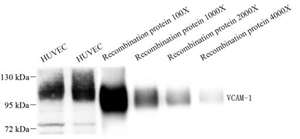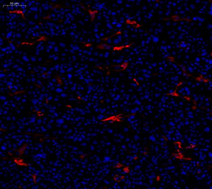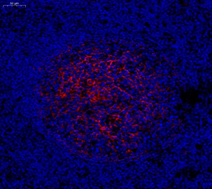Anti-VCAM1 Rabbit pAb (100 μl)
| Reactivity: | H & H & H |
| Applications: | WB & IHC & IF |
| Host Species: | Rabbit |
| Clonality: | Polyclonal |
| Full Name: | VCAM1 rabbit polyclonal |
Gene Name: | Vascular cell adhesion protein 1 |
Synonyms: | CD106, INCAM 100, V CAM 1, VCAM 1, VCAM1 |
Immunogen: | Recombinant protein corresponding to Human VCAM1 |
Isotype: | IgG |
Purity: | Affinity purification |
Subcellular location: | Cell membrane |
Predicted MW. | 81 kDa |
Observed MW. | 85-100 kDa |
Uniprot ID: |
Product Usage Information
Applications | Species | Dilution | Positive tissue |
WB | Human | 1: 500-1: 1000 | HUVEC |
IHC | Human | 1: 500-1: 1000 | tonsil |
IF | Human | 1: 500-1: 1000 | tonsil, liver cancer |
Background
Vascular cell adhesion molecule 1 (VCAM1), also known as CD106, is a 110-kDa transmembrane glycoprotein belonging to the immunoglobulin gene superfamily. VCAM1 is expressed by cytokine-activated endothelium, interacts with integrin VLA4 (α4β1) present on the surface of leukocytes, and mediates both adhesion and signal transduction. It is also expressed either constitutively or inducibly in a variety of other cell types, including vascular smooth muscle cells, differentiating skeletal muscle cells, renal and neural epithelial cells, macrophages (Kupffer cells), dendritic cells, and bone marrow stromal cells.
Images
| Western blot analysis of VCAM1 (GB113376) at dilution of 1: 1000 Lane1-2: HUVEC cell lysate Lane3-6: Recombinant antigen protein lysate in different dilution gradient |
| Immunohistochemistry analysis of paraffin-embedded human tonsil using VCAM1 (GB113376) at dilution of 1: 1000 |
| Immunofluorescent analysis of paraformaldehyde-fixed human liver cancer using VCAM1 (GB113376) at dilution of 1: 1000 |
| Immunofluorescent analysis of paraformaldehyde-fixed human tonsil using VCAM1 (GB113376) at dilution of 1: 1000 |
Storage
| Storage | Store at -20°C for one year. Avoid repeated freeze/thaw cycles. |
| Storage Buffer | PBS with 0.02%sodium azide,100 μg/ml BSA and 50% glycerol. |




